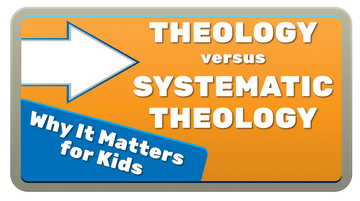Do kids need Systematic Theology?
I’ve heard it plenty of times from both grown-ups and kids:
“I don’t need theology. I just need Jesus.”
But the moment you start explaining who Jesus is, what He did, and why He matters, you’re doing theology.
So theology isn't just for pastors, scholars, and people with massive commentaries on their shelves. It's for regular folks.
And it's especially important for kids.
Teaching theology and doctrine in a way children can understand builds a solid foundation for their faith that will impact the rest of their lives.
Okay, but what is Systematic Theology?
Let's start by comparing it to "regular" theology:
If you were teaching kids Biology, you could go one of two ways:
Clearly, teaching Biology using a logical framework (i.e., systematically) will lead to a deeper understanding and a more useful framework for kids.
→The same is true for theology.
Using a different analogy...
Bible Facts are Puzzle Pieces.
Systematic Theology is the Picture on the Box.
Kids are picking up pieces of the puzzle every time they hear a Bible story — Noah’s ark here, the cross there, maybe a miracle or two. But without systematic theology, they might never see how all the pieces fit into God’s big, beautiful picture.
Why Kids Can (and Should) Learn Systematic Theology
Kids ask big questions:
-
Why did Jesus have to die?
-
How do I know God is real?
-
Will I go to Heaven?
-
Will my pet go to Heaven?
-
Why did God make Satan?
- If God is in control of everything, do my prayers matter?
These are theology questions — and they deserve solid, well-thought-out, true-to-real-life answers rooted in Scripture.
Systematic theology gives kids a framework for understanding the Bible’s big picture.
It connects the dots so they can answer life’s hardest questions with God’s truth — instead of just guessing or going with whatever their friends say.
It’s one of the best ways to help kids develop a biblical worldview that will last into and throughout adulthood.
How to Introduce Systematic Theology to Kids
You don’t need a seminary degree to do this in your home, Sunday School class, or kids' ministry. Just focus on these four principles:
-
Keep it simple. Short, clear sentences for big truths. (Example from Season 5: Incarnation: Jesus is God in a human body.)
-
Define your terms. Words like “justification” and “sanctification” are great — if you explain them in plain language... and some nice graphics don't hurt! (Example from Season 1: Justification is God declaring us righteous; Sanctification is gradually becoming more like Jesus.)
A few more examples:
-
Make it stick. Stories, object lessons, and hands-on activities make abstract truths concrete. (Example from Season 3: The Twirly-Whirly experiment to illustrate evidence for God's existence.)

-
Review often. The more kids hear these concepts, the more they’ll remember. (Every Spyence lesson starts with a review of previous material.)
How Spyence Helps You Do This
Spyence is a gospel-centered, Bible-based curriculum for kids that teaches systematic theology in a way that’s engaging, fun, and unforgettable.
Each Spyence season is built around the big questions of who God is and why that matters, connecting each lesson into the bigger story of the Bible.
We give you:
-
🎥 Action-packed videos that hook kids’ attention

-
🧪 Hands-on science experiments that reinforce theological truths

📜 Detailed teacher scripts so you can confidently explain deep truths in kid-friendly ways
No dry lectures. No “just behave better” moral lessons. 100% real theology, taught in a way kids actually enjoy — and remember.
Ready to Introduce Your Kids to Systematic Theology?
You don’t have to figure this out alone.
Download two free sample lessons to see how Spyence makes systematic theology fun, memorable, and deeply biblical.
👉 Grab Your Free Sample Lessons Here
Because helping kids know about God is good — but helping them know God Himself – that’s the best!






